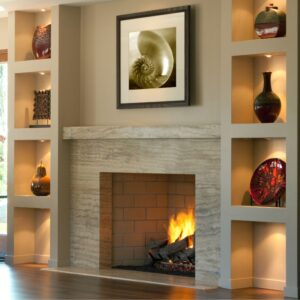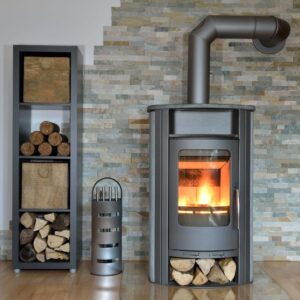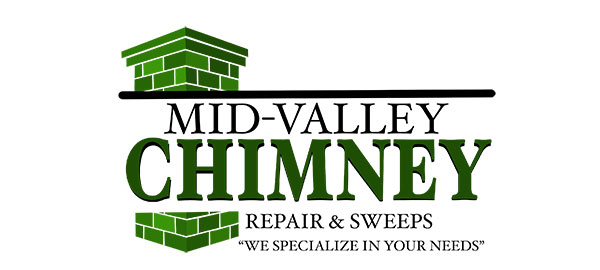Having a spot to enjoy flickering flames and cozy ambient heat adds comfort and style to any home. If you’ve considered adding a heating system or upgrading an existing one, you’ve likely discovered there’s no shortage of options! We’re happy to help you explore and understand what’s possible when it comes to adding a fireplace or stove to your home.
Can I DIY Fireplace Installation?
While some homeowners with savvy might consider installing a home heating system as a DIY project, this particular home improvement project is best left to the pros. After all, this is where you’ll be lighting a fire inside your home.Needless to say, there are risks involved with overlooked considerations or miscalculations in installation.
Among the things our experienced Chimney Safety Institute of America (CSIA) certified technicians can help you do is:
- Assess your space, needs, and preferences
- Help you identify a great fireplace or stove that will check your boxes
- Answer your questions and provide attentive customer service
- Expertly install your appliance with safety, functionality, and efficiency in mind
If you’ve resolved to bring the perfect cozy addition to your home, knowing the differences between a fireplace, a fireplace insert, and a freestanding stove will help you know which direction to go. And if you have questions? Reach out to our team. We’re happy to help.
What Are the Pros & Cons of Fireplaces?
The traditional, open-hearth fireplace is usually the first thing that comes to mind when someone talks about sitting around a fire. Though they come in many designs, fireplaces are known for bringing a charming, classic look to any space.
PROS
 Heat output. Fireplaces can produce substantial radiant heat and are more efficient than in days past, meaning more of that lovely heat gets directed back into your space.
Heat output. Fireplaces can produce substantial radiant heat and are more efficient than in days past, meaning more of that lovely heat gets directed back into your space.- Options. There are lots of options in terms of how your fireplace can look, allowing you to customize to your style preferences. Fireplaces of all styles can improve your home value because of their popular appeal.
- Durability. Masonry is incredibly long-lasting, especially when well maintained. A properly installed fireplace can last a lifetime and beyond.
- Atmosphere. Fireplaces give the total experience – the crackling flames, flickering light, and inviting scent. While alternatives to fireplaces have taken leaps in generating an authentic imitation, traditional fireplaces are still in their own league when it comes to ambiance.
CONS
- Efficiency. Yes, fireplaces are more efficient than they used to be. However, because heat escapes through the chimney, open fireplaces are not the most efficient option.
- Maintenance. Fireplaces require a fair bit of routine maintenance to keep them running optimally.
- Installation costs. Building a new fireplace can be expensive, especially if structural modifications are required.
What Are the Pros & Cons of Fireplace Inserts?
Inserts are closed combustion systems – basically, a fireproof box fronted by glass that’s insulated – that are retrofitted into existing fireplaces. Many include a blower to direct warm air into your living space. Inserts are a great option if you’re looking for a conversion to a different fuel type or higher efficiency system.
PROS
- Greater efficiency. Inserts are engineered for efficiency, which means greater control and less lost heat. They can also heat larger areas.
- Versatility. Inserts come in various designs with many feature options. Because installing an insert is a great time to switch to a new fuel, inserts also give you the freedom to choose the most convenient and cost-effective option – or to switch to a more efficient way to burn the same fuel, which still spells cost savings over time.
- Safety. Fireplace inserts burn more cleanly, with less risk of potentially hazardous fumes entering your space. Also, there’s little to no chance of sparks escaping.
CONS
- Installation limitations. Inserts are installed into fireplaces, which limits placement possibilities.
- Tradition. For those who love the traditional open hearth, inserts may be a less appealing option.
What Are the Pros & Cons of Freestanding Stoves?
Unlike inserts, freestanding stoves don’t need to be installed into an existing fireplace. Rather, they’re standalone appliances positioned on legs or a pedestal that provide lots of radiant heat to the space.
PROS
 Efficiency. Like inserts, stoves are highly efficient. They radiate heat in all directions and have controlled combustion systems.
Efficiency. Like inserts, stoves are highly efficient. They radiate heat in all directions and have controlled combustion systems.- Flexibility. Since they’re freestanding, stoves don’t need to be placed against a wall. This opens up the options for placement. There are also many design and style options, so you’re sure to find one that fits your aesthetic preferences. Stoves come in a variety of styles and sizes – and fuel options, as well.
- Installation. The installation process is pretty straightforward when completed by a professional, so you’ll be enjoying the comfort and cheer of your stove in no time!
CONS
- Less permanence. Stoves are fairly durable, but they won’t have the longevity of a well-maintained fireplace.
- Ambiance. Don’t get us wrong – stoves are cozy. But if you crave the conventional fireplace experience, a freestanding stove may not be what you’re after.
Making the Choice: Ask Our Crew for Help
Navigating the options and making your heating system choice will ultimately depend on your needs, preferences, and budget. But whatever you decide, you can expect to find an option that will elevate your living space with warmth and charm. Get the process going by reaching out to our team today. You can call us at 513-727-0994 or simply reach out online to set up your appointment.
Thanks for trusting us!
